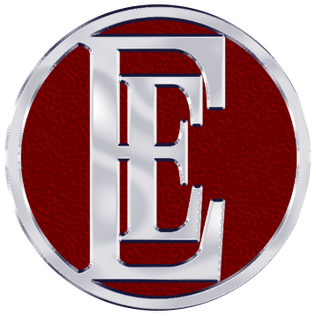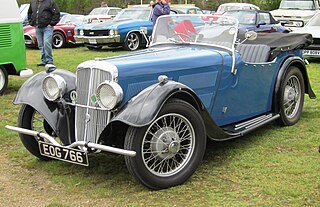
The Birmingham Small Arms Company Limited (BSA) was a major British industrial combine, a group of businesses manufacturing military and sporting firearms; bicycles; motorcycles; cars; buses and bodies; steel; iron castings; hand, power, and machine tools; coal cleaning and handling plants; sintered metals; and hard chrome process.
The Aircraft Manufacturing Company Limited (Airco) was an early British aircraft manufacturer. Established during 1912, it grew rapidly during the First World War, referring to itself as the largest aircraft company in the world by 1918.

The Daimler Company Limited, before 1910 known as the Daimler Motor Company Limited, was an independent British motor vehicle manufacturer founded in London by H. J. Lawson in 1896, which set up its manufacturing base in Coventry. The company bought the right to the use of the Daimler name simultaneously from Gottlieb Daimler and Daimler-Motoren-Gesellschaft of Cannstatt, Germany. After early financial difficulty and a reorganisation of the company in 1904, the Daimler Motor Company was purchased by Birmingham Small Arms Company (BSA) in 1910, which also made cars under its own name before the Second World War. In 1933, BSA bought the Lanchester Motor Company and made it a subsidiary of the Daimler Company.

The English Electric Company Limited (EE) was a British industrial manufacturer formed after the armistice ending the fighting of World War I by amalgamating five businesses which, during the war, made munitions, armaments and aeroplanes.

Riley was a British motorcar and bicycle manufacturer from 1890. Riley became part of the Nuffield Organization in 1938 and was merged into the British Leyland Motor Corporation in 1968. In July 1969 British Leyland announced the immediate end of Riley production, although 1969 was a difficult year for the UK automotive industry and many cars from Riley's inventory may have been first registered in 1970.

Frederick William Lanchester LLD, Hon FRAeS, FRS, was an English polymath and engineer who made important contributions to automotive engineering and to aerodynamics, and co-invented the topic of operations research.

Alvis Car and Engineering Company Ltd was a British manufacturing company in Coventry from 1919 to 1967. In addition to automobiles designed for the civilian market, the company also produced racing cars, aircraft engines, armoured cars and other armoured fighting vehicles.
The Lanchester Motor Company Limited was a British car manufacturer in active trade between 1899 and 1955. Though the Lanchester Motor Company Limited is still registered as an active company and accounts are filed each year, the marque has been dormant since. As of 2014 it is marked as "non-trading".
Carbodies was a taxi design and manufacturing company based in Coventry, England. In its latter years it also traded as London Taxis International and The London Taxi Company.

Sheffield-Simplex was a British car and motorcycle manufacturer operating from 1907 to 1920 based in Sheffield, Yorkshire, and Kingston upon Thames, Surrey.

The Daimler Conquest is an automobile which was produced by The Daimler Company Limited in the United Kingdom from 1953 to 1958. Based on the Lanchester Fourteen, the Conquest replaced the Daimler Consort. Sales were affected by increasing prices and by the fuel shortage caused by the Suez Crisis, and production ended by January 1958, before a replacement model was in production.

The Airco DH.10 Amiens was a twin-engined heavy bomber designed and produced by the British aircraft manufacturer Airco. It performed the first nighttime air mail service in the world on 14-15 May 1919.
Daimler Airway was an airline subsidiary of the Birmingham Small Arms Company (BSA)'s Daimler Company. It was created to use some of the assets of the failed ventures Airco and its subsidiary, Aircraft Transport and Travel, which was acquired by BSA in February 1920.
Laurence Henry Pomeroy (1883–1941) was an English automotive engineer trained as a locomotive engineer and particularly interested in the introduction of light alloys into automotive applications.
Frank Searle CBE, DSO, MIME was a British transport entrepreneur, a locomotive engineer who moved from steam to omnibuses, the motor industry and airlines.

George Holt Thomas was an aviation industry pioneer and newspaper proprietor. In 1911, Holt Thomas founded the business which became Aircraft Manufacturing Company Limited or Airco.

Sir Edward Manville M.Inst.E.E., was a British consulting electrical engineer, industrialist and politician.

BSA cars were manufactured between 1907 and 1912 in Birmingham then until 1939 in Coventry as well as Birmingham, England. BSA had established a motor-car department in an unsuccessful effort to make use of the Sparkbrook Birmingham factory. An independent part of the same site was occupied by The Lanchester Motor Company Limited. Sales were handled by BSA Cycles Limited. After 1912, manufacture was carried out by group subsidiary Daimler in Coventry or BSA Cycles in Birmingham.

The Lanchester Ten and Lanchester Eleven were sold by The Lanchester Motor Company Limited from the Ten's announcement in September 1932 until 1951. Quite different from previous Lanchesters, the Ten was the second of Lanchester's new owner's new Daimler-linked Lanchester range. The names Ten and Eleven referred to the engine's rating for the annual tax and did not relate to the engine's power output.
Peter Hooker Limited owned an engineering business originally established in 1827 and carried on under the name Messrs Peter Hooker as printers' engineers at 12 Pump Row, Old Street Road, St Luke's, later at Pear Tree Court, Farringdon Road, London EC. The limited liability company was formed to own it in 1900. Operations were moved to Black Horse Lane Walthamstow, Essex, in 1901.













